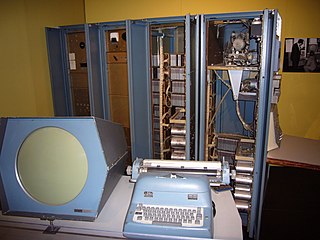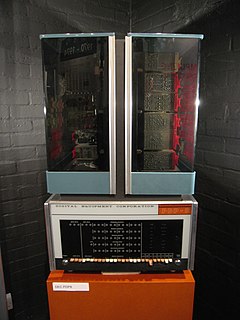
Programmed Data Processor (PDP), referred to by some customers, media and authors as "Programmable Data Processor," is a term used by the Digital Equipment Corporation from 1957 to 1990 for several lines of minicomputers.

The PDP-1 is the first computer in Digital Equipment Corporation's PDP series and was first produced in 1959. It is famous for being the computer most important in the creation of hacker culture at Massachusetts Institute of Technology, BBN and elsewhere. The PDP-1 is the original hardware for playing history's first game on a minicomputer, Steve Russell's Spacewar!

The PDP-8 is a 12-bit minicomputer that was produced by Digital Equipment Corporation (DEC). It was the first commercially successful minicomputer, with over 50,000 units being sold over the model's lifetime. Its basic design follows the pioneering LINC but has a smaller instruction set, which is an expanded version of the PDP-5 instruction set. Similar machines from DEC are the PDP-12 which is a modernized version of the PDP-8 and LINC concepts, and the PDP-14 industrial controller system.

The StrongARM is a family of computer microprocessors developed by Digital Equipment Corporation and manufactured in the late 1990s which implemented the ARM v4 instruction set architecture. It was later sold to Intel in 1997, who continued to manufacture it before replacing it with the XScale in the early 2000s.
Transistor–transistor logic (TTL) is a logic family built from bipolar junction transistors. Its name signifies that transistors perform both the logic function and the amplifying function, as opposed to resistor–transistor logic (RTL) or diode–transistor logic (DTL).

The TX-0, for Transistorized Experimental computer zero, but affectionately referred to as tixo, was an early fully transistorized computer and contained a then-huge 64K of 18-bit words of magnetic core memory. Construction of the TX-0 began in 1955 and ended in 1956. It was used continually through the 1960s at MIT. The TX-0 incorporated around 3,600 Philco high-frequency surface-barrier transistors, the first transistor suitable for high-speed computers. The TX-0 and its direct descendant, the original PDP-1, were platforms for pioneering computer research and the development of what would later be called computer "hacker" culture.

The Freescale 683xx is a family of compatible microcontrollers by Freescale that use a Motorola 68000-based CPU core. The family was designed using a hardware description language, making the parts synthesizable, and amenable to improved fabrication processes, such as die shrinks.

In electronics, emitter-coupled logic (ECL) is a high-speed integrated circuit bipolar transistor logic family. ECL uses an overdriven bipolar junction transistor (BJT) differential amplifier with single-ended input and limited emitter current to avoid the saturated region of operation and its slow turn-off behavior. As the current is steered between two legs of an emitter-coupled pair, ECL is sometimes called current-steering logic (CSL), current-mode logic (CML) or current-switch emitter-follower (CSEF) logic.

The PDP-6 is a computer model developed by Digital Equipment Corporation (DEC) in 1964. It was influential primarily as the prototype (effectively) for the later PDP-10; the instruction sets of the two machines are almost identical.
Resistor–transistor logic (RTL) is a class of digital circuits built using resistors as the input network and bipolar junction transistors (BJTs) as switching devices. RTL is the earliest class of transistorized digital logic circuit used; other classes include diode–transistor logic (DTL) and transistor–transistor logic (TTL). RTL circuits were first constructed with discrete components, but in 1961 it became the first digital logic family to be produced as a monolithic integrated circuit. RTL integrated circuits were used in the Apollo Guidance Computer, whose design was begun in 1961 and which first flew in 1966.
The PDP-5 was Digital Equipment Corporation's first 12-bit computer, introduced in 1963.

DEC 3000 AXP was the name given to a series of computer workstations and servers, produced from 1992 to around 1995 by Digital Equipment Corporation. The DEC 3000 AXP series formed part of the first generation of computer systems based on the 64-bit Alpha AXP architecture. Supported operating systems for the DEC 3000 AXP series were DEC OSF/1 AXP and OpenVMS AXP.

Flip-Chip modules were components of digital logic systems made by the Digital Equipment Corporation (DEC) for its PDP-7, PDP-8, PDP-9, PDP-10, and related computer peripherals, beginning on August 24, 1964.
The Orion was a mid-range mainframe computer introduced by Ferranti in 1959 and installed for the first time in 1961. Ferranti positioned Orion to be their primary offering during the early 1960s, complementing their high-end Atlas and smaller systems like the Sirius and Argus. The Orion was based on a new type of logic circuit known as "Neuron" and included built-in multitasking support, one of the earliest commercial machines to do so.

A transistor computer, now often called a second generation computer, is a computer which uses discrete transistors instead of vacuum tubes. The first generation of electronic computers used vacuum tubes, which generated large amounts of heat, were bulky and unreliable. A second generation computer, through the late 1950s and 1960s featured circuit boards filled with individual transistors and magnetic core memory. These machines remained the mainstream design into the late 1960s, when integrated circuits started appearing and led to the third generation computer.

In electronics, the NORBIT family of modules is a very early form of digital logic developed by Philips that uses modules containing discrete components to build logic function blocks in resistor–transistor logic (RTL) or diode–transistor logic (DTL) technology.
The DEC 4000 AXP is a series of departmental server computers developed and manufactured by Digital Equipment Corporation introduced on 10 November 1992. These systems formed part of the first generation of systems based on the 64-bit Alpha AXP architecture and at the time of introduction, ran Digital's OpenVMS AXP or OSF/1 AXP operating systems.

The VAX 8000 is a discontinued family of superminicomputers developed and manufactured by Digital Equipment Corporation (DEC) using processors implementing the VAX instruction set architecture (ISA).

The T-11, also known as DC310 or DCT11, is a microprocessor that implements the PDP-11 instruction set architecture (ISA) developed by Digital Equipment Corporation. The T-11 was code-named "Tiny". It was developed for embedded systems and was the first single-chip microprocessor developed by DEC. Going into volume production in early 1982, it was sold openly and was used by DEC in disk controllers, the VT240 terminal, auxiliary processors and in the Atari System 2 arcade game system. It operated at 7.5 MHz or 10 MHz, used a 5 V power supply and dissipated 1.1 W maximum. It contained 13,000 transistors, used NMOS logic, and was fabricated in a NMOS process. By 1987, three versions of the DCT11 were available: 21-17311-01, 21-17311-00, and 21-17311-02.
Digital Equipment Corporation (DEC), was a major American company in the computer industry. Founded in 1957 with $70,000 of venture capital, it became "the nation's second-largest computer company, after IBM." Its initial major impact was in minicomputers, but its later-introduced VAX and Alpha systems are still notable.














